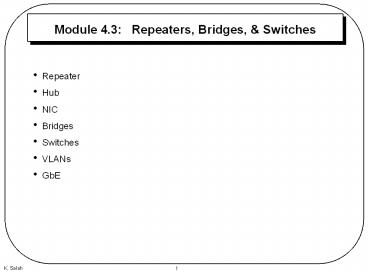Module 4'3: Repeaters, Bridges, - PowerPoint PPT Presentation
Title:
Module 4'3: Repeaters, Bridges,
Description:
... errors, and then switch to the other ports, based on the destination MAC address. ... Port-based. MAC-based. Layer 3/IP. Combination of the above. K. Salah ... – PowerPoint PPT presentation
Number of Views:95
Avg rating:3.0/5.0
Title: Module 4'3: Repeaters, Bridges,
1
Module 4.3 Repeaters, Bridges, Switches
- Repeater
- Hub
- NIC
- Bridges
- Switches
- VLANs
- GbE
2
Hardware Components
- Repeater
- Layer 1 device that provides physical and
electrical connections. - It receives signals from one cable segment,
regenerates, retimes, and amplifies them, and
then transmits these revitalized signals to
another cable segment. - Transmits in both directions
- Joins two segments of cable
- No buffering
- No logical isolation of segments
- Hub
- Used to describe a repeater
- Can be repeater hub, switching hub, bridging
hub. - NIC
- Network Interface Card
- Performs layer-2 functions framing, error
detection, and flow control. - Performs layer-1 functions by converting the bits
into electrical signals using appropriate coding
scheme.
3
Bridges
- Layer 2 devices
- Interconnects two or more individual LANs or LAN
segments. - Desirable for separating traffic among segments.
A segment is part of a LAN in which traffic is
common to all nodes, i.e. it is a single
continuous conductor, though it may include
repeaters. - Split the segment with bridges/switches, if link
utilization is more than 30. - Store-and-forward devices. They capture the
entire frame before deciding whether to filter or
forward it. Frames with bad CRC are not
forwarded. - Minimal buffering to meet peak demand
4
Bridges Standards
- Transparent Bridges
- Operate in promiscuous mode.
- Bridging is transparent to stations, as if they
are on one single LAN. - plug and play unit, learns addresses connecting
to ports by examining source and destination
addresses. - examines the destination address to forward or
filter frames. - All broadcast and multicast frames are forwarded.
- Source Routing Bridges
- Sender provides routing information for frames.
- Routing information includes local or remote
destination address, and list of intermediate
route designators. - A route designator contain 12-bit LAN number and
4-bit bridge number. - Every station has a map of the network (different
routes to get to different destinations). - Routes can be configured manually or by
performing route discovery.
5
Bridges Standards (cont.)
- Network loops can happen. Can cause broadcast
storms that can bring the LAN down. - Spanning Tree algorithm resolves network loops.
- Algorithm is based on graph theory.
- Any connected graph, consisting of nodes and
edges connecting pairs of nodes, there is a
spanning tree of edges that maintains the
connectivity of the graph but contains no closed
loops. - Each LAN is a node and each bridge is an edge.
- Specified in IEEE 802.1. It involves a brief
exchange of messages among all bridges to
discover the minimum-cost spanning tree.
Whenever there is a change in topology, the
bridges automatically recalculate the spanning
tree. - Disabling B3-LAN4 port will result in a spanning
tree. If B4 fails, the algorithm should enable
this port again.
Spanning Tree
6
Switches
- Switches can operate at different layers layer
2, 3, 4, and 7.. - Basically a switch is hardware based, not
software based. - Three types of layer 2 switches
- Store-and-Forward Switch
- Similar to store-and-forward bridge. Store entire
frame, check for errors, and then switch to the
other ports, based on the destination MAC
address. - Cut-Through Switch
- The transmission of frame begins as soon as it
reads the destination MAC address. Two switch
fabric/matrix designs - Crossbar
- Backplane with bus speed gt aggregate port speeds
- Hybrid Switch
- Reliability store-and-forward. Turn ON when
errors are high. - Low latency cut-through. Turn ON when errors are
low.
7
VLANs
- VLAN is a logical grouping of nodes using
Ethernet switches. Nodes dont need to be
connected physically to the same switch. A
broadcast frame will be heard by all nodes within
VLAN. - Benefits
- Isolates broadcasts
- Frees up network from physical locations
- Easily shares resources. A server can be part of
multiple VLANs. - Performance. Easily can be enhanced by creating
new VLANs. - Security. By containing who can listen to
broadcast. - VLAN Membership (implicit tagging)
- Port-based
- MAC-based
- Layer 3/IP
- Combination of the above
8
Gigabit Ethernet
- With GbE CSMA/CD
- Network diameter shrinks to 25 meter. This is
not a good option. - Therefore, minimum frame time was increased to
512 bytes. This give network diameter of 200
meter, but waste in bandwidth especially for
small size data. - Most common use is point-to-point fame switching.
- No CSMA/CD
- We have now 10GbE that can go more than 50 km
over SMF.































